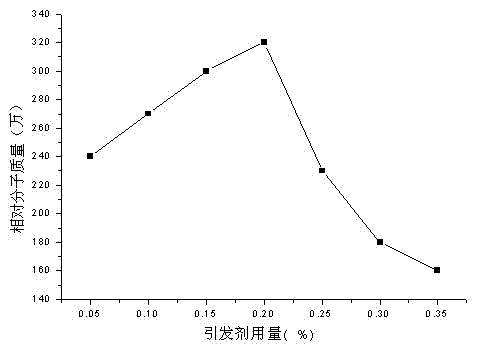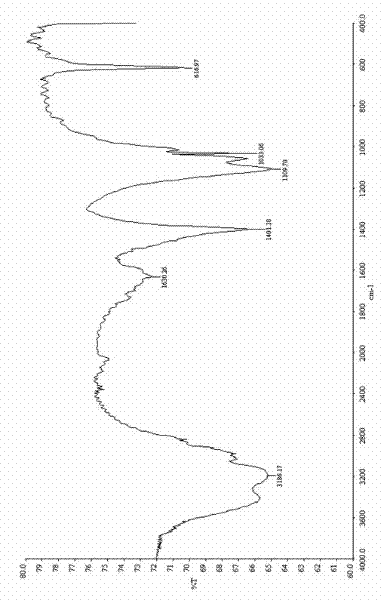Synthetic method of water-in-water type polyacrylamide emulsion
A polyacrylamide and synthesis method technology, applied in the field of chemical synthesis, can solve the problems of difficult stirring, high viscosity, drying, pulverization, poor solubility, etc., and achieve the effect of improving stability
- Summary
- Abstract
- Description
- Claims
- Application Information
AI Technical Summary
Problems solved by technology
Method used
Image
Examples
Embodiment 1
[0056] Install a stirrer, a reflux condenser, a dropping funnel and a thermometer on a 0.5L four-necked bottle, and place it in a water bath. Add 16.0g of monomeric acrylamide, 3.25g of 72% methacryloyloxyethyltrimethylammonium chloride aqueous solution, 56.0g of ammonium sulfate, 16g of stabilizer, 16g of tertiary Butanol and 100ml deionized water, deoxygenated by nitrogen gas for 0.5h. Add 0.03g of ammonium persulfate and 0.02g of sodium sulfite at 18°C to trigger, after 1 hour of reaction, adjust the temperature to 50°C, add 0.03g of 2,2'-azo[2-(2-imidazolin-2-yl ) propane] dihydrochloride, and reacted for 8 h to obtain a polyacrylamide emulsion.
[0057] The performance indicators of polyacrylamide emulsion are as follows:
[0058] Stability: The emulsion is stable for three months without delamination.
[0059] The average molecular weight of polyacrylamide emulsion is 3.2 million.
[0060] The conversion rate of monomer was 99.7%.
Embodiment 2
[0062] Install a stirrer, a reflux condenser, a dropping funnel and a thermometer on a 0.5L four-necked bottle, and place it in a water bath. Add 15.0g monomeric acrylamide, 3.25g mass fraction of 72% methacryloyloxyethyltrimethylammonium chloride (DMC) aqueous solution, 56.0g ammonium sulfate, 14g stabilizer in the four-necked bottle , 15g of tert-butanol and 100ml of deionized water, deoxygenated with nitrogen for 0.5h. Add 0.03g ammonium persulfate and 0.02g sodium sulfite at 18°C to initiate, after 1 hour of reaction, adjust the temperature to 50°C and add 0.03g of 2,2'-azo[2-(2-imidazolin-2-yl) Propane] dihydrochloride (VA-044), react for 6 h to obtain polyacrylamide emulsion.
[0063] The performance indicators of polyacrylamide emulsion are as follows:
[0064] Stability: The emulsion is stable for three months without delamination.
[0065] The average molecular mass of polyacrylamide emulsion is 3.19 million.
[0066] The conversion rate of monomer was 99.5%.
Embodiment 3
[0068] Install a stirrer, a reflux condenser, a dropping funnel and a thermometer on a 0.5L four-necked bottle, and place it in a water bath. Add 16.0g monomeric acrylamide to the four-necked bottle, 3.10g mass fraction is 72% methacryloyloxyethyltrimethylammonium chloride (DMC) aqueous solution, 56.0g ammonium sulfate, 16 g stabilizer, 16g of tert-butanol and 100ml of deionized water, deoxygenated by nitrogen gas for 0.5h. Add 0.04g ammonium persulfate and 0.03g sodium sulfite to initiate at 18°C. After 1 hour of reaction, adjust the temperature to 50°C and add 0.05g of 2,2'-azo[2-(2-imidazolin-2-yl ) propane] dihydrochloride, reacted for 8h to obtain polyacrylamide emulsion.
[0069] The performance indicators of polyacrylamide emulsion are as follows:
[0070] Stability: The emulsion is stable for three months without delamination.
[0071] The average molecular weight of the polyacrylamide emulsion is 3.22 million.
[0072] The conversion rate of monomer is 99.6% 。
PUM
 Login to View More
Login to View More Abstract
Description
Claims
Application Information
 Login to View More
Login to View More - R&D
- Intellectual Property
- Life Sciences
- Materials
- Tech Scout
- Unparalleled Data Quality
- Higher Quality Content
- 60% Fewer Hallucinations
Browse by: Latest US Patents, China's latest patents, Technical Efficacy Thesaurus, Application Domain, Technology Topic, Popular Technical Reports.
© 2025 PatSnap. All rights reserved.Legal|Privacy policy|Modern Slavery Act Transparency Statement|Sitemap|About US| Contact US: help@patsnap.com



